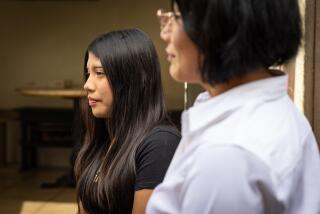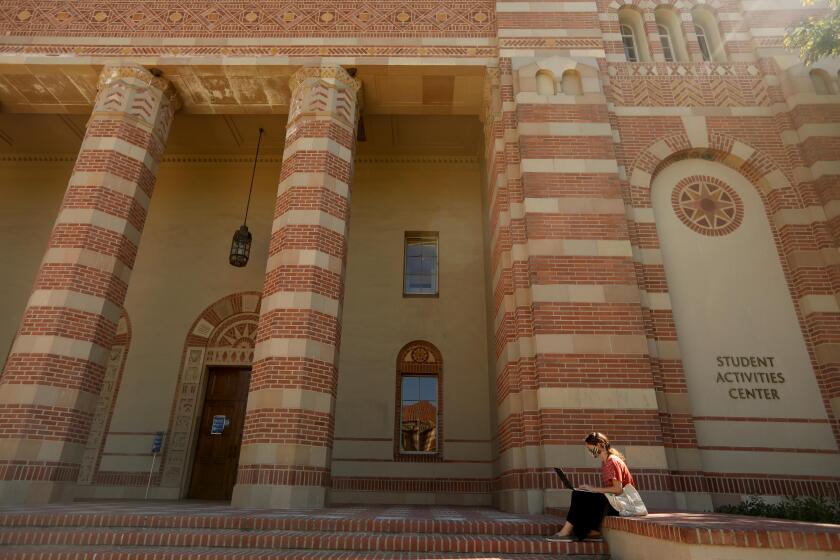California and the West : Study Says 1 in 4 Students Shun Closest School : Education: Amid fervent debate about choice, many already find alternatives to the nearest public campus.
- Share via
Even as a national political debate intensifies over ways to provide parents with alternatives to the nearest public school, the reality is that nearly one in four students already is exercising such a choice either on a public or private campus.
A study to be released today estimates that nearly 8 million children nationally attend charter schools, magnet schools or other alternatives to neighborhood schools that began emerging a generation ago. Federal data show that the number rose steadily during the 1990s and is 2.5 million greater than it was in 1993.
For the record:
12:00 a.m. Sept. 9, 1999 For The Record
Los Angeles Times Thursday September 9, 1999 Home Edition Part A Page 3 Metro Desk 1 inches; 34 words Type of Material: Correction
School group--A story in Wednesday’s paper on school options, about the number of students who choose schools outside their neighborhoods, misidentified a group promoting educational choice. The group is the Center for Education Reform.
Meanwhile, about 6 million children attend private schools, some through publicly and privately funded voucher programs. That number has remained about the same proportionally for at least three decades.
Yet, even as the options have expanded, researchers at UC Berkeley and Stanford University have not been able to find proof that, overall, students are learning more as a result of having such choices.
The findings were compiled from state data and from a federal household survey conducted in 1996 and updated to this year by Policy Analysis for California Education. The think tank’s report is sure to be controversial politically.
Proponents of school vouchers, which provide public money for students to attend private schools, argue that parents don’t have enough choices. The issue has been hotly debated both in political campaigns and in courts.
“Anybody who claims there is a public school monopoly out there is about 20 years behind,” said UC Berkeley professor Bruce Fuller, the report’s lead author. “We’re no longer dragging kids to public schools without any choice.”
The new study says that nearly 500,000 California students already are choosing to attend a school other than the one in their neighborhood. About half of those students are taking advantage of open enrollment policies, which allow them to select a school outside their neighborhood. The rest are attending magnet schools, which offer specialized, intensive programs in topics such as math and science, or charter schools, which operate with greater independence than other public schools.
Open enrollment policies are popular particularly with better-educated families, who are more likely to be white. The report’s authors could find no evidence, however, that participants learned more or were less likely to drop out of school.
Similarly, despite the growth of charter schools to nearly 1,500 nationally, evaluations of their effectiveness are “few in number and often flawed,” the report said.
Experts who have studied existing publicly funded voucher programs in Milwaukee and Cleveland have reached conflicting conclusions about their benefits. A new study of a voucher program in New York, cited by the authors, did show significant student gains.
Advocates of greater school choice contend that alternatives within the public school system are still tightly controlled and limited in number. That is particularly true in urban areas such as Los Angeles, where many children attend schools with ill-prepared and unlicensed teachers and weak test scores. Meanwhile, polls show that education tops the concerns of voters and that support for vouchers is growing.
Last year, the U.S. Supreme Court rejected challenges to Wisconsin’s use of public funds for students to attend religious schools in Milwaukee. But last month, a federal judge in Cleveland blocked such a program there, saying it violated the doctrine of separation of church and state. He later rescinded that order until arguments on the program’s constitutionality could be heard.
Front-running GOP candidate George W. Bush last week revealed that his educational agenda includes providing publicly funded vouchers for private school tuition for children whose public school does not improve. That is similar to provisions of the first statewide voucher program, begun this fall in Florida.
Still, the available alternatives to public schools have not been sufficient to slake the growing thirst for such choices, particularly in urban areas. In the Los Angeles Unified School District, for example, the number of slots available in schools for open enrollment has shrunk dramatically over the past five years.
In 1995, the nearly 700,000-student school district made 21,000 classroom slots available on a first-come, first-served basis to children who preferred to leave their neighborhood school. Rising enrollments and policies reducing class sizes to no more than 20 pupils through the third grade have taken all but 6,000 of those slots off the table.
“We’re into choice,” said Bruce Takeguma, L.A. Unified’s assistant director of school management services. “But the trend is not optimistic, given the enrollment numbers we’re dealing with and the programs that require more and more space at our school campuses.”
The district’s magnet school program is similarly oversubscribed, with 70,000 children applying for 13,000 seats in 1996. The same thing is true nationally, with more than 90% of 173 districts reporting waiting lists to get into magnet schools.
Magnet schools first appeared about 20 years ago as a way to encourage voluntary desegregation by encouraging middle-class parents not to flee to the suburbs. Typically, such schools spend more than others, have more experienced teachers and, studies have found, help students make significantly greater progress academically.
But Paul E. Peterson, a voucher advocate who directs the program on educational policy and governance at Harvard University’s John F. Kennedy School of Government, said such programs are not set up to serve the needs of inner-city children attending the lowest-performing schools.
Moreover, the impact of magnet schools and other alternatives to neighborhood schools spotlighted by the new report pales in comparison to the choices available to middle-class parents.
“Most people in the United States have a choice, because they can pick the suburb they live in. And when you pick your suburb, you pick your school,” Peterson said. “The segment of the population that has very little choice is low-income people living in cities.”
Terry Moe, a senior fellow at the Hoover Institution and an advocate of vouchers who reviewed the study, said the growth of charter schools is the most encouraging trend noted in the report. But he criticized the limit on the growth of such schools in California to no more than 100 a year.
The Clinton administration is encouraging the creation of as many as 3,000 charter schools, offering $300,000 to each campus over three years to subsidize start-up costs. This fall, 10% of the students in the Washington, D.C., school district will be attending charter schools.
Marshall S. Smith, acting deputy secretary of Education, said the new report demonstrates that “there’s a really rich menu out there in many communities made up of public school options.”
But, he acknowledged, despite the growth of alternatives to neighborhood schools, “there are still people who have children in the public schools that are failing where there is no choice.”
Jeanne Allen, president of the Center for School Reform, a Washington, D.C.-based group promoting educational choice, said the growth of such programs is accelerating and is forcing public schools to improve.
“People are shopping [for educational alternatives], and you don’t start taking choices away once they’ve engaged in shopping,” she said.
(BEGIN TEXT OF INFOBOX / INFOGRAPHIC)
Growth in School Choice Programs
More students nationwide and in California are enrolling in public school choice programs, according to a study by researchers at Policy Analysis for California Education.
*
Students in public school choice programs in California, 1997:
*
Students in public school choice programs in Los Angeles Unified School District, 1998-99
*
Note: Figures may not total 100 because of rounding.
*
Sources: Policy Analysis for California Education, California Department of Education, National Center for Educational Statistics
More to Read
Sign up for Essential California
The most important California stories and recommendations in your inbox every morning.
You may occasionally receive promotional content from the Los Angeles Times.










